

New York City draft riots. The New York City draft riots (July 13–16, 1863; known at the time as Draft Week[2] were violent disturbances in New York City that were the culmination of working-class discontent with new laws passed by Congress that year to draft men to fight in the ongoing American Civil War.
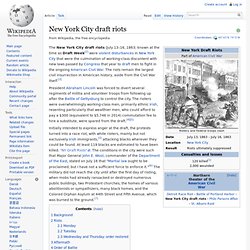
The riots remain the largest civil insurrection in American history, aside from the Civil War itself.[3] President Abraham Lincoln was forced to divert several regiments of militia and volunteer troops from following up after the Battle of Gettysburg to control the city. The rioters were overwhelmingly working-class men, primarily ethnic Irish, resenting particularly that wealthier men, who could afford to pay a $300 (equivalent to $5,746 in 2014) commutation fee to hire a substitute, were spared from the draft.[4][5] Background[edit] New York's economy was tied to the South; by 1822 nearly half of its exports were cotton shipments.[8] In addition, upstate textile mills processed cotton in manufacturing. Draftriotmap_large.jpg (JPEG Image, 750 × 561 pixels) Map Of New York and Vicinity. / Dripps, Matthew / 1863. Map Of New York and Vicinity.
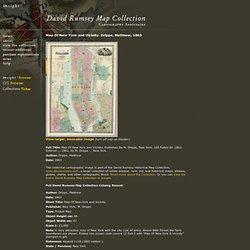
Dripps, Matthew, 1863 View larger, zoomable image (turn off pop-up blocker) Full Title: Map Of New York and Vicinity. Published By M. Dripps, New York. 103 Fulton St. 1863. Author: Dripps, Matthew Date: 1863 Full David Rumsey Map Collection Catalog Record: Short Title: Map Of New York and Vicinity. Publisher: New York: M. Type: Pocket Map Object Height cm: 66 Object Width cm: 47 Scale 1: 23,000. Tammany Hall. Copperhead (politics) Copperhead pamphlet from 1864 During the American Civil War (1861–1865), the Copperheads nominally favored the Union and strongly opposed the war, for which they blamed abolitionists, and they demanded immediate peace and resisted draft laws.

They wanted President Abraham Lincoln and the Republicans ousted from power, seeing the president as a tyrant destroying American republican values with despotic and arbitrary actions. [citation needed] Some Copperheads tried to persuade Union soldiers to desert. They talked of helping Confederate prisoners of war seize their camps and escape. Five Points, Manhattan. Five Points intersection painted by George Catlin in 1827; the triangular building in the center is located on what would be known as "Paradise Square", Anthony Street veers off to the right, Cross Street on the left and Orange Street runs left to right in the foreground The name Five Points was derived from the five-pointed intersection created by Orange Street (now Baxter Street) and Cross Street (now Mosco Street); from this intersection Anthony Street (now Worth Street) began and ran in a northwest direction, creating a triangular-shaped block thus the fifth "point".

To the west of this "point" ran Little Water Street (which no longer exists) north to south, creating a triangular plot which would become known as Paradise Square or Paradise Park. Five Points gained international notoriety as a disease-ridden, crime-infested slum that existed for well over 70 years.[1] History[edit] Collect Pond[edit] Main article: Collect Pond. The Old Brewery. The Old Brewery The brewery was built by Isaac Coulthard[1] southeast of a body of freshwater known as the Collect Pond.
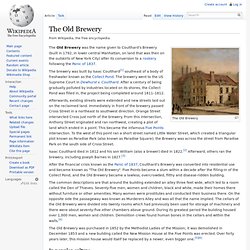
The brewery went to the US Supreme Court in Dewhurst v. Coulthard. After a century of being gradually polluted by industries located on its shores, the Collect Pond was filled in, the project being completed around 1811–1812. Bloody Tubs. Formed in the mid-1850s, the gang became known as the Bloody Tubs for their method of dunking political opponents in slaughterhouse tubs.
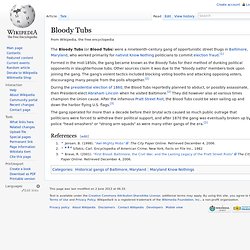
Other sources claim it was due to the "bloody oaths" members took upon joining the gang. Plug Uglies. The Plug Uglies were a street gang, sometimes referred to as a political club, that operated in the west side of Baltimore, Maryland from 1854 to 1860.
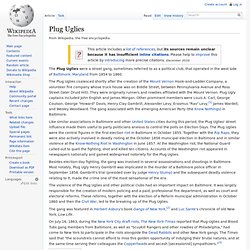
The Plug Uglies coalesced shortly after the creation of the Mount Vernon Hook-and-Ladder Company, a volunteer fire company whose truck house was on Biddle Street, between Pennsylvania Avenue and Ross Street (later Druid Hill). They were originally runners and rowdies affiliated with the Mount Vernon. Plug Ugly captains included John English and James Morgan. Other prominent members were Louis A. Bowery Boys. For the group of actors who made a series of films between 1946 and 1958, see The Bowery Boys.
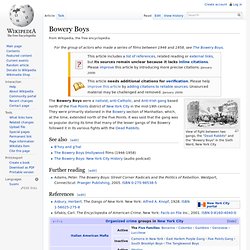
View of fight between two gangs, the "Dead Rabbits" and the "Bowery Boys" in the Sixth Ward, New York City See also[edit] Further reading[edit] Adams, Peter. Dead Rabbits. VNY: Draft Riots Aftermath. Fishing Creek Confederacy. On August 21, 1864, the soldiers began traveling up Fishing Creek.

For the next week, they searched the northern portion of Columbia County for deserters and draft evaders. They were unable to find any, but on August 28 they arrested 100 local citizens. Most were released, although some were taken to Fort Mifflin. The soldiers continued heading into the northernmost reaches of the Fishing Creek watershed. Unable to find any evidence of a conspiracy, they returned to Bloomsburg and remained in the county until December 1864.
Background[edit] In response to the draft law, meetings in Stillwater and Jerseytown resolved that "A war carried on contrary to the rules and provisions of [the Constitution], whether it be a crusade against slavery, or any other fanatical or delusory scheme, never can and never will receive our support Initial search for deserters[edit] Solomon Taylor ordered the group of locals not to fire.